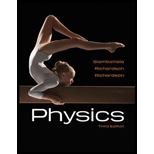
Concept explainers
(a)
Find the ratio of the
(a)
Answer to Problem 102P
The ratio of the angular momentum for rotating star is
Explanation of Solution
Write the equation for angular momentum of a rigid object.
Here,
For a rigid object rotating around a fixed axis, angular momentum does not tell us anything, because the rotational inertia is constant for such an object since the distance
Conservation of angular momentum: If the net external torque acting on a system is zero, then the angular momentum of the system cannot change. This is the law of conservation of momentum.
The law of conservation of momentum is expressed as,
Here,
Conclusion:
Since, from the above explanation the rotating star is converted into the pulsar under the influence of gravity. This pulsar does not have any shape so it is can be considered as rigid object. The rotational inertia is constant for such an object.
Since the angular momentum is conserved, the ratio is 1.
(b)
Find the ratio of the angular velocity for rotating star.
(b)
Answer to Problem 102P
The ratio of the angular momentum for rotating star is
Explanation of Solution
From the equation (I), write the equation for angular velocity of the object.
Write the equation for the inertia of the rotating body.
Here,
Rewrite equation (III) by using equation (IV).
Since, from the equation (III) and (V) the rotational inertia is proportional to the square of the radius.
Conclusion:
The ratio of the angular velocities is.
Here,
The radius of the pulsar is
Therefore, the ratio of the angular momentum for rotating star is
(c)
Find the ratio of the rotational kinetic energy of the star after collapse to the values of before collapse.
(c)
Answer to Problem 102P
The ratio of the rotational kinetic energy of the star is
Explanation of Solution
Write the equation for the rotational kinetic energy.
Here,
Rewrite the equation (I) for
Rewrite equation (VI) by using equation (VII).
Conclusion:
The ratio of the rotational kinetic energies of the star is.
The radius of the pulsar is
Therefore, the ratio of the rotational kinetic energy of the star is
(d)
The period of the star’s rotation after collapse.
(d)
Answer to Problem 102P
The period of the star’s rotation is
Explanation of Solution
Write the equation for the period related to the angular velocity.
Here,
Conclusion:
The period of the star after collapse is.
Here,
Rewrite the above equation for
The radius of the pulsar is
Substitute
Therefore, period of the star’s rotation after collapse is
Want to see more full solutions like this?
Chapter 8 Solutions
Physics - With Connect Access
 College PhysicsPhysicsISBN:9781305952300Author:Raymond A. Serway, Chris VuillePublisher:Cengage Learning
College PhysicsPhysicsISBN:9781305952300Author:Raymond A. Serway, Chris VuillePublisher:Cengage Learning University Physics (14th Edition)PhysicsISBN:9780133969290Author:Hugh D. Young, Roger A. FreedmanPublisher:PEARSON
University Physics (14th Edition)PhysicsISBN:9780133969290Author:Hugh D. Young, Roger A. FreedmanPublisher:PEARSON Introduction To Quantum MechanicsPhysicsISBN:9781107189638Author:Griffiths, David J., Schroeter, Darrell F.Publisher:Cambridge University Press
Introduction To Quantum MechanicsPhysicsISBN:9781107189638Author:Griffiths, David J., Schroeter, Darrell F.Publisher:Cambridge University Press Physics for Scientists and EngineersPhysicsISBN:9781337553278Author:Raymond A. Serway, John W. JewettPublisher:Cengage Learning
Physics for Scientists and EngineersPhysicsISBN:9781337553278Author:Raymond A. Serway, John W. JewettPublisher:Cengage Learning Lecture- Tutorials for Introductory AstronomyPhysicsISBN:9780321820464Author:Edward E. Prather, Tim P. Slater, Jeff P. Adams, Gina BrissendenPublisher:Addison-Wesley
Lecture- Tutorials for Introductory AstronomyPhysicsISBN:9780321820464Author:Edward E. Prather, Tim P. Slater, Jeff P. Adams, Gina BrissendenPublisher:Addison-Wesley College Physics: A Strategic Approach (4th Editio...PhysicsISBN:9780134609034Author:Randall D. Knight (Professor Emeritus), Brian Jones, Stuart FieldPublisher:PEARSON
College Physics: A Strategic Approach (4th Editio...PhysicsISBN:9780134609034Author:Randall D. Knight (Professor Emeritus), Brian Jones, Stuart FieldPublisher:PEARSON





